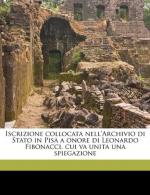|
This section contains 341 words (approx. 2 pages at 300 words per page) |
Encyclopedia of World Biography on Leonardo Fibonacci
The Italian mathematician and merchant Leonardo Fibonacci (ca. 1180-ca. 1250), also known as Leonardo of Pisa, was the most original and capable mathematician of the medieval Christian world.
Leonardo Fibonacci was born in Pisa and was brought up in Bougie, Algeria, where his father was a warehouse official. Fibonacci traveled extensively for business and pleasure throughout Europe and in Egypt, Syria, and Greece. During his travels he observed and analyzed the arithmetical systems employed in commerce and learned the Hindu-Arabic numerals. He helped to introduce them into European mathematics.
In the Liber abaci (1202; revised version 1228), a thorough treatise on algebraic methods and problems, Fibonacci strongly advocates the use of the new Indian numerals, that is, the nine numerals, plus the zephirum, or symbol for zero. This work can be regarded as symptomatic of the mathematical renaissance of the West. In it, Fibonacci deals with the fundamental operations on integers, with fractions, with the extraction of roots, and with mathematical applications to commercial transactions. The Liber abaci also contains the famous "Fibonacci sequence," where each term after the first two is the sum of the two terms immediately preceding it, a sequence that has been found to have many significant and interesting properties. The Liber abaci remained a standard work for about 2 centuries.
In another work, entitled Flos (1225), Fibonacci considers indeterminate problems that are reminiscent of the work of Diophantus and analyzes determinate problems with methods similar to those employed by Euclid, the Chinese, and the Arabs. Another mathematical treatise by Fibonacci, the Liber quadratorum (1225), is an original and brilliant work on indeterminate analysis. Some of the problems dealt with in this book derived from the mathematical contests sponsored by the court of Frederick II, to which Fibonacci had been invited.
Though he was primarily an arithmetician and an algebraist, Fibonacci also wrote a book on geometry entitled Practica geometriae (1220), which seems to be based on Euclid's lost work On the Division of Figures. In his work Fibonacci uses algebraic methods to solve a large number of arithmetical and geometrical problems.
|
This section contains 341 words (approx. 2 pages at 300 words per page) |


